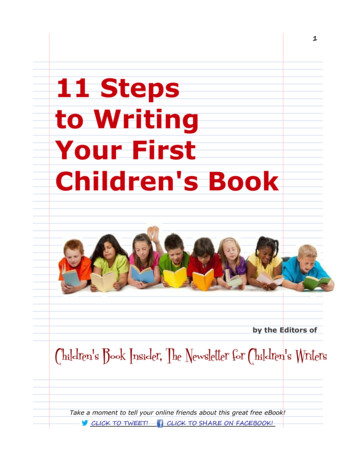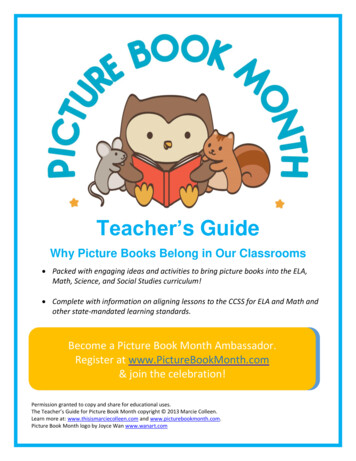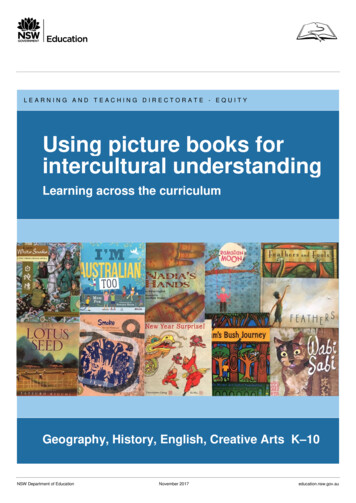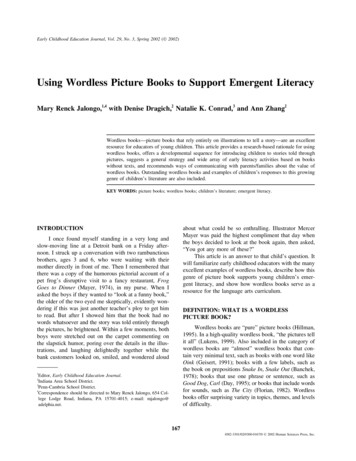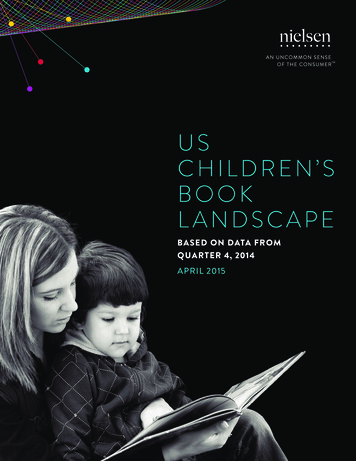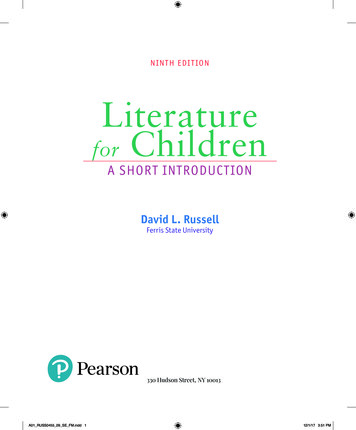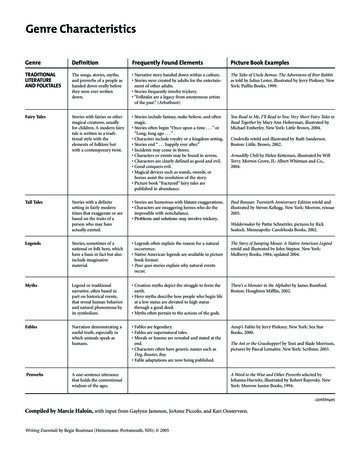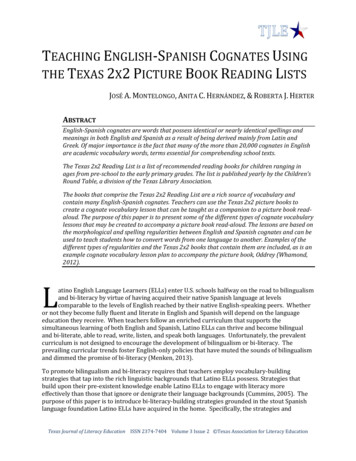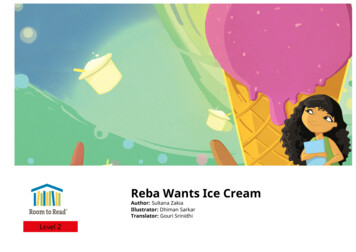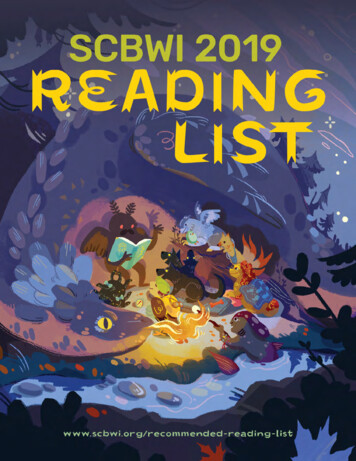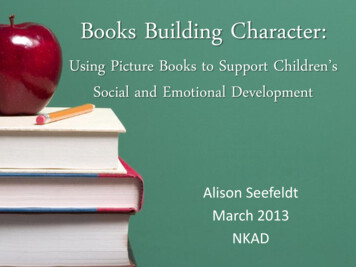
Transcription
Books Building Character:Using Picture Books to Support Children’sSocial and Emotional DevelopmentAlison SeefeldtMarch 2013NKAD
Today’s Purpose To help you support yourstudents’ social and emotionalgrowth using literature To learn about specific titlesthat can support social andemotional growth To discuss how to engagefamilies in this type of reading
Introductions A little about me How this workshop came to be Favorite book or character
Social and EmotionalDevelopment What does that mean to you? What are the three mostimportant social and emotionalskills you’d like children to learnin your classroom?
What Social and EmotionalSkills Do Children Need toSucceed in School? Confidence Ability to develop good relationships withpeers and adults Concentration and persistence onchallenging tasks Ability to effectively communicateemotions Ability to listen to instructions and beattentive Ability to solve social problems(Adapted from ingSECompetenceTACSEI.pdf)
What Do the ELFs Say? Self-concept– SE36 Explore and participate in activities andmaterials designed to build understanding ofindividual characteristics and of diversity inculture, family structure, ability, language, ageand gender in non-stereotypical ways Self-regulation– SE38 Recognize, label and express a range offeelings and needs appropriately– SE39 Begin to understand that feelings areseparate from actions and that it is acceptableto have a range of feelings Social relationships and cooperation– SE50 Develop awareness of other’sperspectives and gain an understanding of howtheir actions impact those around them
Why Use Picture Books? Need for explicitteaching andintentional supportfor social/emotionalskill development Support children indealing with therange of challengesthey face
Literature can Help children better understandlife experiences Provide insights into humanbehaviors, emotions, dilemmas Stimulate curiosity Develop problem-solving skills Inform with facts, concepts, newunderstanding, demystifies Provide comfort Model coping strategies bywalking readers through possiblesolutions or ways to cope
Why Teach This Way? To teach our students emotionalintelligence To promote academic success To build classroom community
“Books are mirrors in whichchildren can see themselves.When they are represented inthe literature we read, they cansee themselves as valuable andworthy of notice.”—A World of Difference Institute 2009
What Attributes Do We Need toTeach This Way? RespectGenuineness
Benefits of Reading Aloud Builds literacy skills– Comprehension– Oral Language– Vocabulary– Print Knowledge– Critical Thinking Strengthens adult-child bond Builds general cognitive skills
"The single most important activity forbuilding the knowledge required foreventual success in reading is readingaloud to children."On Becoming a Nation of Readers: TheReport on the Commission on Reading“Extensive research has proven thatreading aloud to a child is the singlemost important factor in raising areader. These inexpensive 15 minutes aday are the best-kept secret inAmerican education.”Jim Trelease, Read-Aloud Handbook
Literacy Autobiography See Handout When did you learn to read? How were youtaught to read? Did you have favorite books as achild? When did you learn to write? How were youtaught to write? Do you have any memories ofparticular pieces? Do you have any pleasant or unpleasantmemories related to literacy learning at school? How did you feel about reading and writing as yougrew up? What is the place of literacy in your lifetoday? Has it had a positive or negative influence?Do you have favorite authors or books? Based on your experience, how to do you thinkyoung children should learn to read and write?
Types of Literature Social/emotional books– Written explicitly to teachsocial/emotional skills– Builds vocabulary– Instructional format Authentic children’s literature– Tells a good story in its own right– Addresses challenging issues withina storyline– Often more engaging
What is High-QualityLiterature? Topics and themes that children enjoy orneed Pleasing illustrations that are accurate to theplot, characters, and setting Pictures and words avoid stereotyping Length and amount of text appropriate tothe age or development of the child Offer something to the reader and listener Not written for a strictly instructionalpurpose
Selecting High-QualityLiterature Can use professional recommendations andawards as guides
2013 Charlotte ZolotowAward winnerEach Kindness by JacquelineWoodson
Evaluating Children’sBooks Do illustrations or text depictstereotypes? Is author knowledgeable about thetopic? Are problems solved realistically? Does writing style encouragediscussion? What kind of language does authoruse to describe people? Is story developmentally appropriateand interesting?Adapted from Mankiw, S., & Strasser, J. (2013). Tender topics:Exploring sensitive issues with pre-k through first gradechildren through read-aloud. Young Children, 68(1).
High-Quality Literature—Why Does It Matter? Children whose caregivers were better ableto select high-quality books demonstratedgreater empathy and social/emotionaladjustment (Aram & Aviram, 2009) Encourages complex thinking, questioningskills, and comprehension (Hassett, 2009) With high-quality literature – Characters serve as role models forappropriate behavior– Metaphors help children make connectionsto their own lives– Strong characters and storylines make iteasier to engage children in discussionsrelated to social and emotional concepts
Sharing Stories Use before, during, and afterreading strategies Ask questions and haveconversation Make it comfortable and fun Make connections and extendthe story
Before Reading Sit in a comfortable place in closeproximity with the child. Look at the front cover and read thetitle, author, and illustrator. Reviewwhat an author and illustrator do. Review the parts of a book: front cover,back cover, spine. Look at the illustration on the frontcover and make a prediction about thestory. Take a picture walk through the story,without revealing the ending. Introduce vocabulary that may bechallenging.
During Reading Read with expression. Ask questions throughout thestory about the characters,plot, print and vocabulary. Encourage children toparticipate verbally and makepredictions. Find vocabulary words anddiscuss them in context.
After Reading Ask questions about the story. Help the child makeconnections:– Text-to-self– Text-to-world– Text-to-text Do an activity to reinforce theconcepts in the book.
Types of Prompts: CROWD Completion (pause, let them finishthe sentence) Recall (“What happened in thestory?”) Open-ended (“How do youthink ”) Wh- (“Why? Where? Who?When? What?”) Distancing (“Has that everhappened to you?” Higher-level,making connections)
Teaching Vocabulary Select words before reading Come up with child-friendlydefinitions Find words in context Revisit words after reading Provide concrete experienceswith the words
Child-Friendly Definitions ComfortFierceCelebrateAdventure
Literature and Tender Topics What are tender topics? Not enough to give children accessto books about these topics Consider child’s developmental leveland family contexts Value of including these booksregularly in your classroomAdapted from Mankiw, S., & Strasser, J. (2013). Tender topics: Exploringsensitive issues with pre-k through first grade children through readaloud. Young Children, 68(1).
Literature and Tender Topics Be sensitive to circumstances andpersonalities Introduce sensitive issues/contentbeforehand Provide opportunities for responding tobooks – orally, through art, writing,movement, etc. Honor children’s unique response to books Read the same book for several days toprovide more opportunities for children totalk about the story and own experiences Use to embed social-emotional skillsbuilding into everyday activities: circletime, art, music, science, math, dramaticplay
Bibliotherapy Basically: helping through books Clinical vs. developmental– Clinical Bibliotherapy is implemented bytrained helping professionals dealing withsignificant emotional or behavioral problems– Developmental Bibliotherapy may be used byteachers, librarians or lay helpers to facilitatenormal development Psychologists have effectively usedchildren’s literature as therapy tools forchildren needing emotional support (Aram& Aviram, 2009) Plausible that parents and teachers coulduse these books in a similar way (Ableser,2008)
Stages of DevelopmentalBibliotherapy1. Identification– Process by which reader identifies witha character in the book– Book characters can be very real tochildren– Text to self connection2. Surfacing of Emotions (the Catharsis)– Occurs as reader follows the characterthrough a difficult situation to asuccessful resolution
Stages of DevelopmentalBibliotherapy3. Insight– Reader develops an awareness of thecharacter’s situation to their own life– Reflects on the story and makes an awarenesstransfer which fosters self-understanding– Can lead to changed attitudes and hopefullychanged behavior4. Universalization– Truly can identify with the character presentedin the text/story/picture book– Child can relate to how the story characterhandled a situation and can see relationships intheir own life
Using Literature toSupport Social andEmotional Development FeelingsFriendshipSelf-ConceptDiversityFamily Events
Using Literature toSupport Social andEmotional Development What are some other social andemotional skills or tender topicsyou might want to use literatureto teach?
Time to Practice! How would you use one ofthese titles in your classroom? What social and emotionalskill(s) would you highlight? What discussion questionscould you ask? What extension activity couldyou do?
Example Titles When Sophie Gets Angry, Really,Really Angry (Feelings) It’s Okay to be Different (SelfConcept) A Chair for My Mother (Family) Whoever You Are (Diversity) Yo! Yes? (Friendship)
Engaging Families—WhyDoes It Matter? Exposure to storybooks during parent-childshared reading in K significantly related tovocabulary knowledge in K as well as time spentreading for pleasure in 4th grade (Sénéchal, 2006) Affective environment of home storybook readingsignificantly related to the amount of chapterbook reading in 3rd grade, even after controllingfor the frequency of storybook reading and thereading ability (Baker, Mackler, Sonnenschein, &Serpell, 2001) More parents and children focused on nonimmediate content of book, more positive theaffective environment (Baker, Mackler,Sonnenschein, & Serpell, 2001) Matters not just that parents spend time readingwith children but how they engage them indiscussion (Hassett, 2009)
Engaging FamiliesHow can you encourage familiesto read like this?
Engaging Families Lending library of books withdiscussion guides Family literacy nights Talk to families about topicsthey’d like titles for Highlight a book in classnewsletters
It’s Okay to Be DifferentDiscussion Guide Title: It’s Okay to Be DifferentAuthor: Todd ParrTopic: Self-ConceptNotes for Reading:– Todd Parr says he wrote this book to empower children to feel good about themselves.– Vocabulary to talk about: medium, embarrassed, adoptedQuestions to Discuss:– Did you think this book was funny? What parts?– Do you do or like any of the same things as the characters in the story?– What makes you unique?– What are some good things about being different?– What are some ways that you and I are different?Activity Ideas:– Reread this book, allowing your child to help you read. Have them use the illustrations togive them clues about the text.– With your child, draw a picture or create a collage showing what makes him or her unique.
Using the Books andDiscussion Guides Before sitting down to read to a child,read the “Notes for Reading” and lookat the vocabulary words. Decide if these vocabulary words areappropriate. Select alternate words ifyou’d like. Introduce the book. Read the story, encouragingconversation throughout. Use the discussion questions afterreading or select your own questions. Do at least one activity to reinforce theconcepts learned in the story.
Thank You!seefeldt@udel.edu
ReferencesAbleser, J. (2008). Authentic literacy experiences to teach and supportyoung children during stressful times. Young Children, 63(2), 74-81.Aram, D., & Aviram, S. (2009). Mothers’ storybook reading andkindergarteners’ socioemotional and literacy development.Reading Psychology, 30, 175-194. doi:10.1080/02710802275348Baker, L., Mackler, K., Sonnenschein, S., & Serpell, R. (2001). Parents’interactions with their first-grade children during storybookreading and relations with subsequent home reading activity andreading achievement. Journal of School Psychology, 39, 415-438.doi:10.1016/S0022-4405(01)00082-6Hassett, D. D. (2009). Children’s literature and early literacy success:Using the Charlotte Zolotow Award collection in early childhoodteacher education. Journal of Early Childhood Teacher Education,30, 363-384. doi:10.1080/10901020903320296Mankiw, S., & Strasser, J. (2013). Tender topics: Exploring sensitiveissues with pre-k through first grade children through read-aloud.Young Children, 68(1).Sénéchal, M. (2011). A model of the concurrent and longitudinalrelations between home literacy and child outcomes. In S. B.Neuman & D. K. Dickinson (Eds.), Handbook of Early LiteracyResearch, Volume 3, (175-188). New York, NY: The Guildford Press.
books – orally, through art, writing, movement, etc. Honor children’s unique response to books Read the same book for several days to provide more opportunities for children to talk about the story and own experiences
